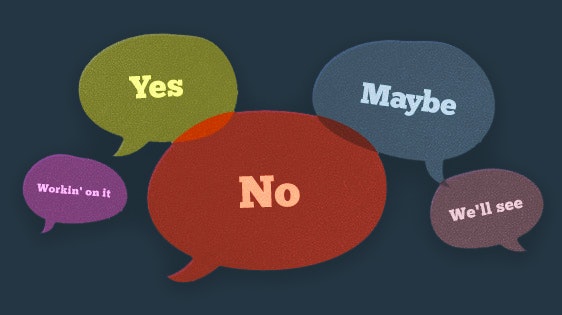Globally, there seems to be a general reluctance to tell someone “no.”
This reluctance promotes a lifelong game of translating subtle expressions or tone. Some of the most delicate need-to-say-no-but-I-can’t scenarios occur with customers. In this dilemma, we’re all acutely aware of the potential for losing someone’s business.
There will be occasions when you must deliver a “no” to a customer. In these instances, we offer you sage advice:
Do not use the word "no."
It is not necessary to get your point across, and more likely than not it will just aggravate the recipient since it’s not a word that any of us associate with positivity.
Instead, follow these tips to say no without saying "no."
Set clear expectations
The easiest way to rarely have to say no is to set clear expectations for your customers. Make sure that you articulate the capabilities of your product.
Alternately, your team needs to be aware of the limitations of what you’re selling. This way, you don’t make any promises you can’t keep, and the customer shouldn’t have any false expectations.
Think of creative solutions
If your instinctive reaction to a customer’s request is to say no, fight it! We are in the creative solutions business. Ask yourselves the following questions before you tell the customer you can’t complete their request:
Do I understand the customer’s perspective regarding this problem?
Am I clear on their objectives? Can I help them meet any of their objectives?
Is the product we’re selling functioning as it’s intended? Is it fulfilling the capabilities we advertise?
Is there any alternative I can offer them?
Can a colleague help me solve this problem?
How to say no
If you believe you’ve exhausted all the solutions that are available to you, then bite the bullet and respond to the customer that you’re unable to complete their request. Consider these ways to approach this for a successful outcome:
Give a timely response. Quick responses are highly valued by customers. Make sure you respond to a customer’s concern within 24 hours, even if it is just to let them know you are working on the problem.
Be honest. Assure the customer that you have done due diligence to try to solve the problem. Clearly explain why you are unable to help them at this time.
Be tactful with your phrasing. Delivery is everything here. A simple “no, I can’t help you” will never, ever be the correct response to a customer. Using a positive tone, politely but firmly explain that you have exhausted possible solutions. If it is appropriate in the context, express your hope that you can do business with them again in the future.
Listen carefully. The customer may be displeased that you can’t solve their problem; make sure you courteously hear them out and respond in a professional and respectful manner.
Be sincere. Do not send out a form response with an empty apology. On that note, if you don’t have anything to apologize for, then don’t. Cater your response to the specific request made by the customer and make sure your email reflects your voice.






